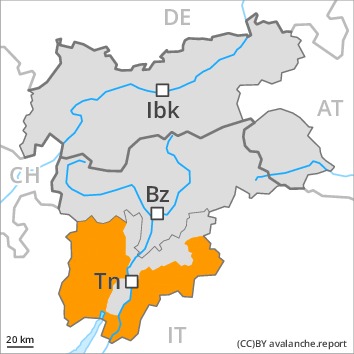
Danger level
Avalanche Problem
 | | Persistent weak layer |
|  | |  |
 | | Wind-drifted snow |
|  | |  |

As before, it is inadvisable to engage in backcountry touring and snowshoe hiking in steep terrain.
The new snow and wind slabs are very prone to triggering. Medium-sized and, in isolated cases, large dry slab avalanches are possible in all aspects. Even single backcountry tourers can release avalanches in many places. As a consequence of solar radiation, the natural avalanche activity will increase, caution is to be exercised on steep slopes also below the tree line.
Whumpfing sounds and the formation of shooting cracks when stepping on the snowpack are a clear indication of a weakly bonded snowpack. Remotely triggered avalanches are possible.
In particular on steep grassy slopes medium-sized and, in isolated cases, large gliding avalanches are possible. Extensive experience in the assessment of avalanche danger and great restraint are required.
Snowpack
Towards its surface, the snowpack is unfavourably layered; its surface consists of loosely bonded snow. The new snow and wind slabs are bonding only slowly with the old snowpack in all aspects. In some places new snow and wind slabs are lying on surface hoar. Faceted weak layers exist in the centre of the snowpack in particular on shady slopes. Towards its base, the snowpack is well consolidated.
The more recent wind slabs are covered with new snow and therefore barely recognisable. As a consequence of low temperatures the snowpack can not consolidate during the next few days.
Tendency
A critical avalanche situation will persist in some cases. The weather conditions will prevent a rapid strengthening of the near-surface layers.

Danger level
 | 1600m
|
Avalanche Problem
 | | Persistent weak layer |
|  | |  |
 | | Persistent weak layer |
|  | |  |

As before, it is inadvisable to engage in backcountry touring and snowshoe hiking in steep terrain.
As a consequence of solar radiation, the natural avalanche activity will increase. The new snow and wind slabs are very prone to triggering. Medium-sized and, in isolated cases, large dry slab avalanches are possible in all aspects. Even single backcountry tourers can release avalanches in many places, caution is to be exercised on steep slopes also below the tree line.
Whumpfing sounds and the formation of shooting cracks when stepping on the snowpack are a clear indication of a weakly bonded snowpack. Extensive experience in the assessment of avalanche danger and great restraint are required. The avalanche prone locations are widespread. Remotely triggered avalanches are possible.
In particular on steep grassy slopes medium-sized and, in isolated cases, large gliding avalanches are possible.
Snowpack
dp.8: surface hoar blanketed with snow
Towards its surface, the snowpack is unfavourably layered; its surface consists of loosely bonded snow. Distinct weak layers exist in the snowpack in all aspects. Slopes adjacent to ridgelines are especially precarious. The more recent wind slabs are covered with new snow and therefore barely recognisable.
As a consequence of low temperatures the snowpack can not consolidate.
Towards its base, the snowpack is well consolidated.
Tendency
A very precarious avalanche situation will prevail. The weather conditions will prevent a rapid change towards better conditions.











